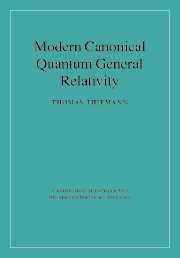Book contents
- Frontmatter
- Contents
- Foreword, by Chris Isham
- Preface
- Notation and conventions
- Introduction: Defining quantum gravity
- I CLASSICAL FOUNDATIONS, INTERPRETATION AND THE CANONICAL QUANTISATION PROGRAMME
- II FOUNDATIONS OF MODERN CANONICAL QUANTUM GENERAL RELATIVITY
- III PHYSICAL APPLICATIONS
- IV MATHEMATICAL TOOLS AND THEIR CONNECTION TO PHYSICS
- 18 Tools from general topology
- 19 Differential, Riemannian, symplectic and complex geometry
- 20 Semianalytic category
- 21 Elements of fibre bundle theory
- 22 Holonomies on non-trivial fibre bundles
- 23 Geometric quantisation
- 24 The Dirac algorithm for field theories with constraints
- 25 Tools from measure theory
- 26 Key results from functional analysis
- 27 Elementary introduction to Gel'fand theory for Abelian C*-algebras
- 28 Bohr compactification of the real line
- 29 Operator *-algebras and spectral theorem
- 30 Refined algebraic quantisation (RAQ) and direct integral decomposition (DID)
- 31 Basics of harmonic analysis on compact Lie groups
- 32 Spin-network functions for SU(2)
- 33 + Functional analytic description of classical connection dynamics
- References
- Index
23 - Geometric quantisation
Published online by Cambridge University Press: 04 August 2010
- Frontmatter
- Contents
- Foreword, by Chris Isham
- Preface
- Notation and conventions
- Introduction: Defining quantum gravity
- I CLASSICAL FOUNDATIONS, INTERPRETATION AND THE CANONICAL QUANTISATION PROGRAMME
- II FOUNDATIONS OF MODERN CANONICAL QUANTUM GENERAL RELATIVITY
- III PHYSICAL APPLICATIONS
- IV MATHEMATICAL TOOLS AND THEIR CONNECTION TO PHYSICS
- 18 Tools from general topology
- 19 Differential, Riemannian, symplectic and complex geometry
- 20 Semianalytic category
- 21 Elements of fibre bundle theory
- 22 Holonomies on non-trivial fibre bundles
- 23 Geometric quantisation
- 24 The Dirac algorithm for field theories with constraints
- 25 Tools from measure theory
- 26 Key results from functional analysis
- 27 Elementary introduction to Gel'fand theory for Abelian C*-algebras
- 28 Bohr compactification of the real line
- 29 Operator *-algebras and spectral theorem
- 30 Refined algebraic quantisation (RAQ) and direct integral decomposition (DID)
- 31 Basics of harmonic analysis on compact Lie groups
- 32 Spin-network functions for SU(2)
- 33 + Functional analytic description of classical connection dynamics
- References
- Index
Summary
As an application of the concepts of Chapters 19, 21 and in order to see their interplay in a concrete physical application, we sketch the main ideas of geometric quantisation. This will also provide the necessary background material for the treatment of quantum black holes in LQG.
Geometric quantisation concerns the quantisation of an arbitrary symplectic manifold (M, ω) using only natural symplectic structures during the quantisation process. It consists of three steps: (1) prequantisation, (2) polarisation and (3) quantisation. In the first step one is able to quantise every function on phase space in a natural representation, provided that a certain topological condition, Weil's integrality criterion, is satisfied. The famous Groenwald–van Hove theorem is evaded because that representation is highly reducible. In order to obtain an irreducible representation one has to invoke the polarisation step which selects a subspace of the Hilbert space. The final step then consists of finding the induced subrepresentation of the operators.
The strength of geometric quantisation is that it applies to the case when M is not a cotangent bundle, for example, when M is compact. Its weakness is that only a limited number of functions on phase space survive the final quantisation step because they are supposed to preserve the subrepresentation. This is in particular a problem for Hamiltonians and/or constraints which are polynomials of high degree in the momenta, which is why one can usually apply geometric quantisation in its strict form (i.e., without introducing factor ordering ambiguities) only on the reduced phase space constructed in Section 19.3.
- Type
- Chapter
- Information
- Modern Canonical Quantum General Relativity , pp. 652 - 670Publisher: Cambridge University PressPrint publication year: 2007

